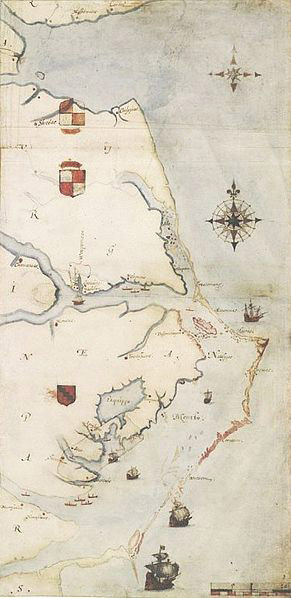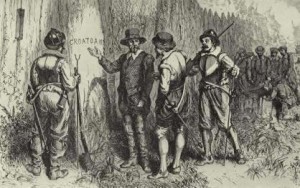 The Roanoke Colony, also known as the Lost Colony, was an early settlement established on Roanoke Island off the shore of North Carolina. Intended as a permanent English settlement, the colony was financed and organized by Sir Walter Raleigh under a charter granted by Queen Elizabeth I. Under this charter, Raleigh had seven years to establish a settlement before losing colonization rights. Raleigh funded the expedition under the leadership of Ralph Lane and Richard Grenville.
The Roanoke Colony, also known as the Lost Colony, was an early settlement established on Roanoke Island off the shore of North Carolina. Intended as a permanent English settlement, the colony was financed and organized by Sir Walter Raleigh under a charter granted by Queen Elizabeth I. Under this charter, Raleigh had seven years to establish a settlement before losing colonization rights. Raleigh funded the expedition under the leadership of Ralph Lane and Richard Grenville.
Early Exploration
On July 4, 1584, an expedition led by Phillip Amadas and Arthur Barlowe landed on Roanoke Island. Tasked by Raleigh with exploring the Eastern coast, they established a rudimentary settlement and made contact with the local Secotan and Croatan tribes. After some exploration, Barlowe returned to England with two Croatans and gave Raleigh an update on the local geography and politics. Based on this report, which was also corroborated by the Croatans, Raleigh organized a second expedition led by Grenville.
Five primary ships under Grenville’s command left Plymouth on April 9, 1585. A storm separated the Tiger, carrying Grenville, from the rest of the fleet off the coast of Portugal. However, the ship captains had laid contingency plans to meet in Puerto Rico if the fleet became separated. The Tiger arrived first and Grenville initiated relations with the Spanish and began construction of a fort while waiting for the rest of the fleet.
While the Elizabeth eventually arrived in Puerto Rico, the other ships did not. Grenville decided to proceed to the Eastern coast without them. Unfortunately, the Tiger ran aground of a shoal upon entering Ocracoke Inlet, which damaged the ship and destroyed most of the food supplies aboard. After repairing the ship, the Tiger and the Elizabeth proceeded to the Outer Banks where they discovered the Dorothy and the Roebuck, which had arrived several weeks previously. The fifth ship, the Red Lion, had dropped off passengers and left for Newfoundland.
Roanoke Colony Settlement
 Once the four ships were reunited, the men began exploration of the local area, including the mainland and the villages located along the coast. During their explorations, relations with the local tribes suffered due to an incident with residents of the village of Aquascogoc. Natives were accused of theft of a silver cup. The English explorers retaliated by sacking and burning the village, resulting in hard feelings between the explorers and the local tribes.
Once the four ships were reunited, the men began exploration of the local area, including the mainland and the villages located along the coast. During their explorations, relations with the local tribes suffered due to an incident with residents of the village of Aquascogoc. Natives were accused of theft of a silver cup. The English explorers retaliated by sacking and burning the village, resulting in hard feelings between the explorers and the local tribes.
After exploring the area, Grenville elected to leave Lane and 107 members of the expedition to form a settlement on the north end of Roanoke Island while he returned to England for supplies and more men. Grenville and those he took with him departed in April of 1585 while Lane began construction of a small fort. Following Grenville’s departure, the fort was completed and exploration of the local area continued.
The relief fleet did not appear when expected the following year and hard feelings remaining from the stolen cup incident led to an attack on the fort. The settlers were able to hold off the attack, but without supplies and relief forces, were unable to expand their foothold in the area. Shortly after the attack, Sir Francis Drake stopped on his way from a raid in the Caribbean. Drake offered to transport the men back to England, an offer they accepted.
Shortly after the colonist’s departure with Drake, the relief fleet finally arrived. With the fort abandoned, Grenville left a small contingent of men to maintain a presence and to protect Raleigh’s claim and returned to England with the bulk of his expedition.
Second Attempt
After the initial abandonment of the fort, Raleigh sent a further expedition of 150 men under the command of John White to the Chesapeake Bay to establish a new colony. The group arrived in North America under orders to first gather the men left at Roanoke Island before establishing a new settlement. However, when they arrived at the Roanoke Colony, they found it completely empty except for a single skeleton.
Despite initial plans to settle on the Chesapeake Bay, the fleet’s commander refused to allow the settlers to return to the ships following the discovery of the abandoned fort. With no other choice, White gave orders to reestablish the Roanoke Colony and attempted to establish friendly relations with the local Indians. While he succeeded with the Croatans, he was unable to form friendly relationships with the hostile tribes Lane battled the preceding year.
Following the death of George Howe, who was killed by hostile Indians while searching for crabs, the colonists convinced White to return to England for help. White left for England and left behind approximately 115 colonists, including his granddaughter, the first English child born in the colonies.
White returned to England and pleaded for reinforcements and help. Unfortunately, circumstances prevented the timely return to the Roanoke Colony. Delays caused by weather and the need for English ships to fight the Spanish Armada prevented White from returning as quickly as hoped. He eventually hired two small ships not needed in the conflict with the Spanish, but the ships were captured by the Spanish and their goods taken. With no supplies to deliver, the ships returned to England.
Abandoned Colony
After a three year delay caused by the hostilities with the Spanish, White finally mounted another resupply attempt. Booking passage on a privateering expedition, White convinced them to stop at Roanoke Island during the return trip from the Caribbean. Upon landing on August 18, 1590, White found the colony completely deserted. No sign of any of the colonists was found except the word “Croatoan” carved into a post and “Cro” carved into a tree. Buildings had been taken down, indicating the colonists did not leave in a hurry, but left intentionally.
Based on the words carved, White assumed the colonists moved to nearby Croatoan Island. Due to an impending storm, the men refused to search further and insisted they leave before the storm’s arrival. White and the rest of the expedition returned to England without knowing the fate of the colonists.
Twelve years later, Raleigh decided to further investigate the disappearance of the members of the Roanoke Colony. In 1602, he sent an expedition led by Samuel Mace to seek evidence of the colony’s fate. Hoping to still profit from the voyage, Mace’s ship spent time in the Outer Banks gathering woods and plants to be sold in England. Due to this delay, they were unable to complete the voyage to Roanoke Island before the weather became too dangerous. The expedition returned to England without ever making it to the Roanoke Colony site. Back in England, Raleigh had been arrested for treason and no future expeditions were mounted to determine the fate of the colonists.
The final fate of the Roanoke Colony remains a mystery. Several theories exist with varying levels of evidence supporting each. One commonly held opinion is that the colonists left the fort and were gradually integrated into the local tribes. Other opinions range from the complete movement of the colony to a failed attempt to return to England. Numerous modern attempts to discover the eventual fate of the colonists continue, ranging from archeological exploration to DNA projects designed to establish if any descendants of the colonists remain.